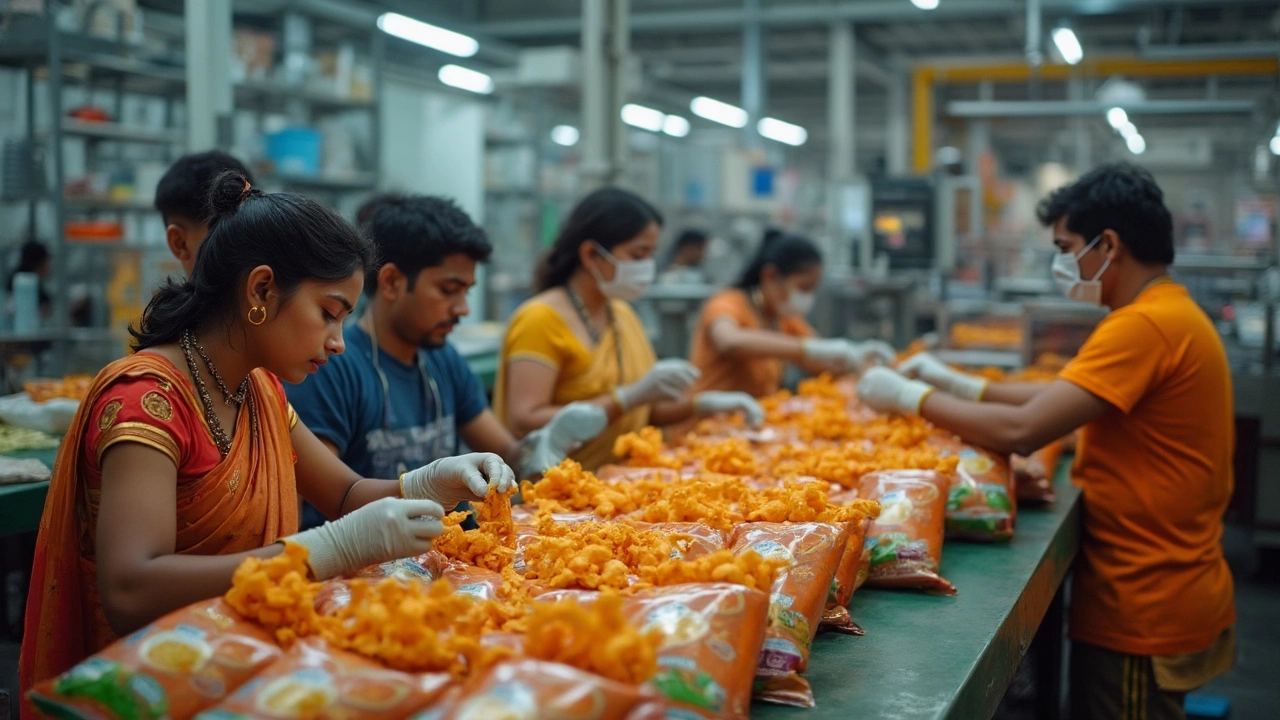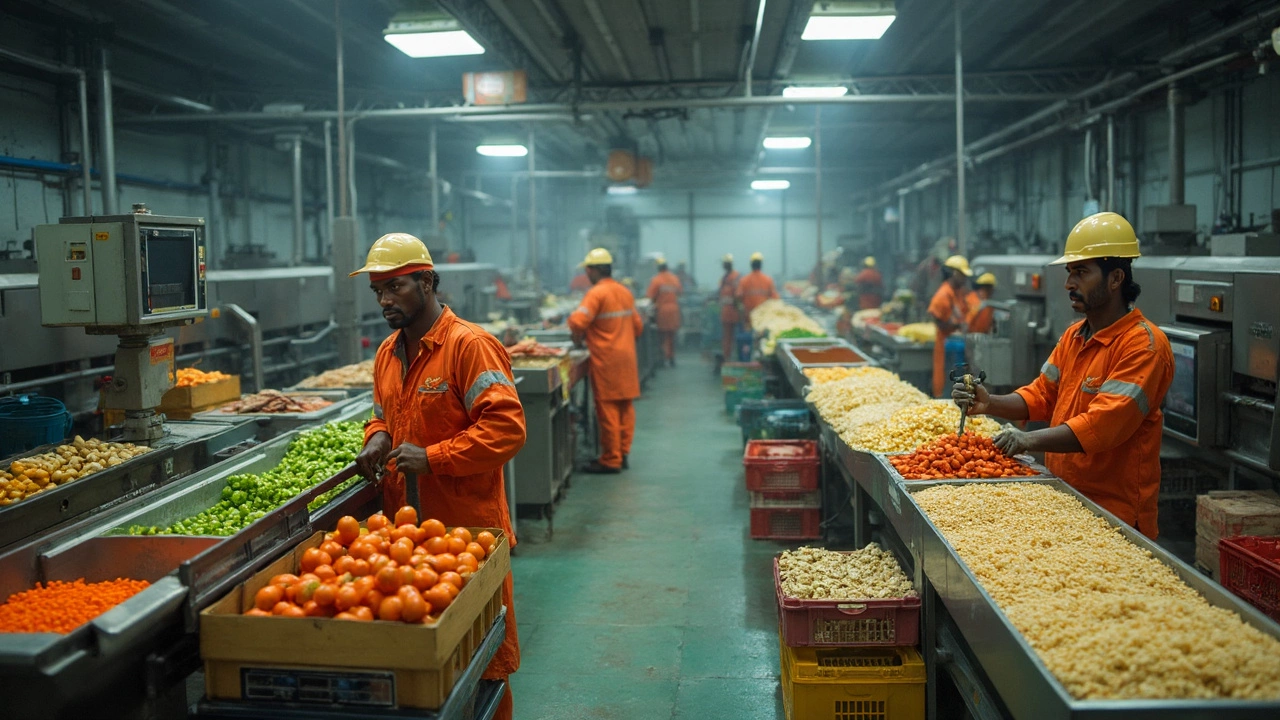Ever wonder how your favorite cereal or frozen veggies go from the farm to your kitchen? It’s not as simple as picking and packing—food has to go through a whole lineup of processing steps before it's ready for you. Each operation inside a food processing unit has a specific job, whether it’s making sure your salad is clean or your cookies keep their crunch for weeks.
Most people only see the final product, but the real action happens behind the scenes. Think about all the different textures and flavors at the supermarket—those don’t just “happen.” There’s real science and serious machinery working around the clock. And you’d be surprised by how much tech is involved, even for basic things like peeling potatoes or making bread dough stretchier.
Still, every operation, from washing and chopping to mixing and heating, matters for taste, shelf life, and even your health. Food processing is really about turning something raw and sometimes risky into something you can trust and enjoy. Stick around to see what happens at each step and catch some tips if you ever want to try your hand at safe food prep at home.
- What Exactly Happens in Food Processing Units?
- Cleaning and Sorting: The First Line of Defense
- Mixing, Grinding, and Other Transformation Operations
- Preservation: Keeping Food Safe and Fresh
- Packaging and Storage: Sealing the Deal
- Tips, Trends, and Surprising Facts
What Exactly Happens in Food Processing Units?
Step inside a food processing unit and you’ll quickly see it’s all about turning raw food into something safe, tasty, and ready for the store. These places are a mix of science lab, kitchen, and factory—every spot specialized for a different job. The goal? Quality, safety, and efficiency, all at the same time.
The journey usually begins as soon as crops or raw meat shipments arrive. Food processing units get everything—grains, veggies, fruits, dairy, meat. First off, they’re sorted and cleaned to get rid of dirt, bugs, or anything you’d never want in your dinner. The next steps break down or combine these ingredients by chopping, grinding, mixing, or sometimes even fermenting. It's why that tomato becomes ketchup, and wheat turns into bread.
Here’s a quick look at main stages inside a food processing unit:
- Receiving & sorting: Checking for quality and tossing out any bad batches.
- Cleaning: Removing soil, pesticides, and bacteria—think of it as a massive high-pressure wash station.
- Cutting, mixing, and grinding: Machines do the tough stuff, from dicing potatoes to blending ingredients for snacks.
- Heating or cooling: Cooking destroys harmful germs, while freezing keeps things fresh longer.
- Preserving: Adding salt, sugar, or even drying to stop spoilage.
- Packing: Sealing everything in a way that locks out air, bugs, and bacteria. Sometimes they even vacuum-seal or use nitrogen gas to keep chips crispy.
Most units are obsessed with safety, and for good reason. A salmonella mess-up can cost a company millions and wreck its reputation. In fact, over 90% of modern food operations use automated checks with sensors that can spot issues faster than a human ever could. That’s a big reason why you rarely hear about major food recalls.
Here’s a snapshot comparing different food processing operations and the time each typically takes:
| Operation | Avg. Time Per Batch |
|---|---|
| Cleaning/Sorting | 10-30 mins |
| Mixing/Grinding | 15-45 mins |
| Heating (Pasteurization) | 10-20 mins |
| Packaging | 5-15 mins |
This streamlining doesn’t just save money; it helps make sure you’re getting food that’s safe, consistent, and up to industry standards. Next time you eat packaged food, remember: a small army of machines and skilled workers made sure it was ready for you.
Cleaning and Sorting: The First Line of Defense
The first thing that happens when food enters food processing units is a deep clean. No one wants to bite into an apple and find a chunk of dirt or a stray pebble. That’s why cleaning is non-negotiable, especially for fruits, veggies, and grains. Big processors use high-pressure water sprays, air blowers, or even ultrasonic waves to wash away soil, bugs, and chemical residues. This step makes the food safer and helps it last longer, since leftover dirt can speed up spoilage or carry germs.
Next comes sorting. Factories rely on machines—sometimes with cameras or lasers—to pick out the good from the bad. Tomatoes that are too squishy or potatoes with major bruises get tossed. This isn’t just about looks; damaged or spoiled produce can mess with both taste and food safety. For example, in big grain processing plants, special sifters remove stones, damaged seeds, and even stray metal pieces before anything gets ground up.
- Food operations save tons of time thanks to automation. One study found that modern optical sorting systems can separate fruits for quality 30% faster than manual labor.
- The better the cleaning stage, the less chance there is of carrying molds, bacteria, or toxins into the next step. It’s a chain reaction—miss something now and problems just multiply later.
- Processors often use food-safe sanitizers or ozone treatments when a simple water wash isn’t enough, like with leafy greens that can hide dirt deep inside the leaves.
| Type of Food | Common Sorting Criteria | Cleaning Method |
|---|---|---|
| Grains | Size, broken seeds, foreign objects | Aspiration, washing, sieving |
| Fruits & Veggies | Ripeness, size, color, defects | Water sprays, brushes, ozone wash |
| Seafood | Species, size, shell pieces | Water agitation, hand picking |
Catching issues early means less food waste and safer products for everyone. If you’re sorting or cleaning food at home, try rinsing produce under running water and cut away any bad spots right away—this simple move can cut pesticide and bacteria load by a surprising amount, according to the FDA.
Mixing, Grinding, and Other Transformation Operations
You might not realize it, but a lot of your favorite foods get their taste and texture from food processing steps like mixing, grinding, and transforming. Without these, bread would be a lump, burgers would fall apart, and ice cream would be icy chunks instead of smooth scoops.
Mixing is about getting ingredients fully blended so every bite is the same, whether you're making peanut butter, cake batter, or salad dressing. Food processing units use huge mixers that can handle hundreds of liters at a time, way bigger than your kitchen bowl. Some mixers add air on purpose to make things fluffy, like in whipped cream.
Then there’s grinding. This step breaks down bigger pieces into smaller ones—think turning wheat into flour or beef into ground meat. Grinding also matters for stuff like spices, giving them a stronger punch and making sure they blend nicely into recipes. It plays a big role in texture, and even food safety. For example, grinding cuts down cooking time, which helps kill off germs faster.
But that’s not the whole story. Other transformation operations help food change shape or structure. Here’s how:
- Homogenizing: Smooths out products so things like milk don’t separate into cream and water. That’s why your milk looks the same from the first pour to the last.
- Emulsifying: Makes liquids blend when they normally wouldn’t, like combining oil and vinegar in mayonnaise. Special machines spin things crazy fast to get this effect.
- Kneading: Used for dough, this step develops gluten in bread and pizza, giving the chewy texture everyone loves.
- Extruding: Pushes food doughs through a shape—think pasta noodles, breakfast cereals, or even some snack chips. Extruders also cook as they shape, thanks to heat and pressure.
Just to give you an idea of the scale, check out this quick look at how much food processing units can handle per hour:
| Operation | Capacity (Typical Industrial Unit) |
|---|---|
| Mixing batter | 500–1000 kg/hour |
| Grinding wheat | 2,000–10,000 kg/hour |
| Extruding snacks | 500–1500 kg/hour |
Pretty wild, right? It’s not just about big numbers. The exact settings—like how long to mix or how fine to grind—have a huge impact. Even tiny changes can mess up the look or taste. That’s why food processing experts run tests to get it just right before anything hits the stores. If you mess with the mixing speed or grinding time at home, you’ll notice a difference, too. It’s the science of great food, plain and simple.

Preservation: Keeping Food Safe and Fresh
If you’ve ever wondered why your bread gets moldy in days but canned beans last for years, it all comes down to food processing techniques for preservation. This part of the process isn’t just about keeping food from spoiling. It also helps lock in flavor, texture, and nutrition.
There are several common ways that food processing units keep products safe and tasty. Some methods have been around for ages—think pickling or drying—while others, like high-pressure processing, are powered by cutting-edge technology.
- Pasteurization: This is not just for milk. Pasteurization gently heats food to kill off dangerous bacteria and extend shelf life. Juices, sauces, and even some canned goods go through this step.
- Freezing: Lowering the temperature, quickly, is the easiest way to make food last. Freezing stops bacteria in its tracks and keeps texture solid. That’s why frozen veggies usually taste a lot like fresh.
- Canning: Here’s where food is sealed air-tight in cans or jars and then heated. It’s how you get chili or peaches that can last in your cupboard for years. The combo of heat and sealing wipes out germs and locks out air.
- Drying: Removing water from food makes it almost impossible for mold and bacteria to grow. Raisins, instant coffee, and beef jerky all use this trick.
- Additives and Preservatives: Sometimes, a chemical like ascorbic acid (vitamin C) or salt is added. These ingredients slow down spoilage and boost safety. Don’t worry, the use of these is pretty strictly regulated.
Worried about nutrition? While certain vitamins (like vitamin C) can get lost in very high-heat processes, most modern food processing tries to keep as many nutrients as possible. In fact, frozen fruits and veggies can have more vitamins than the ones sitting on store shelves for too long.
| Method | Typical Shelf Life | Main Benefit |
|---|---|---|
| Freezing | 6-18 months | Locks in nutrients, stops bacteria |
| Canning | 1-5 years | Long shelf life, kills bacteria |
| Drying | 6-12 months | Lightweight, minimal storage needs |
| Pasteurization | 7-21 days (refrigerated) | Reduces harmful microbes |
Here’s a tip: Store canned or dried foods in a cool, dry place at home. And for any frozen products, don’t let them thaw and refreeze—it actually changes texture and lets bacteria sneak back in. Next time you’re checking labels at the store, now you’ll know which food processing steps helped your food stay fresh and safe to eat.
Packaging and Storage: Sealing the Deal
Once food is processed and ready, it needs to stay fresh, safe, and good-looking until you eat it. That’s where packaging and storage come into play. At any food processing unit, these steps matter just as much as the processing itself. Packaging isn’t just about slapping a label on a box; it protects against damage, keeps out germs, and stops food from going stale or soggy.
A lot rides on picking the right packaging. Glass jars work well for stuff that can spoil, like jams or sauces. Plastic works for snacks because it’s light and doesn’t break. Vacuum-sealed bags are perfect for keeping cheese and deli meats fresh, since air is one of the top reasons food spoils. The food industry even uses modified atmosphere packaging (MAP), where they swap out the air with gases like nitrogen to help chips and salad greens last longer on store shelves.
If you walk into any big food industry warehouse, foods are stored at just the right temperature and humidity. Freezers keep things like frozen veggies or ice cream rock-solid, while dry goods like rice hang out in cool, dry warehouses. Even the way things are stacked matters—a crushed box of crackers isn’t fun for anyone.
Check this out for a quick glance at why packaging choices matter:
| Type of Packaging | Best For | Major Benefit |
|---|---|---|
| Glass Jars | Jams, Sauces | Blocks oxygen, reusable |
| Plastic Pouches | Snacks, Spices | Lightweight, flexible |
| Metal Cans | Soups, Beverages | Long shelf life, durable |
| Vacuum Packs | Meats, Cheese | Keeps products fresher longer |
Smart storage is just as key. If milk isn’t stored cold through transport and at the store, it spoils fast. That’s why cold chain logistics—a fancy term for keeping stuff cold every step of the way—matters a lot in the food processing world. Poor packaging or sloppy storage means more waste, less taste, and maybe even unsafe food.
Tip: If you ever shop in bulk, storing dry goods in airtight containers at home works almost as well as the pros do it. And if you like to meal prep, grabbing a roll of vacuum-sealer bags for leftovers can seriously cut down on waste and loss of fresh flavor.
Tips, Trends, and Surprising Facts
Let’s get into some honest tips and cool updates about food processing that might change how you look at your favorite foods. Whether you’re curious about what’s really happening behind those factory doors, or just want to know what’s hot in the industry this year, you’re in the right spot.
- Always check labels for “minimally processed” or “ultra-processed.” Minimal means basic steps like cleaning and freezing, while ultra-processed usually means lots of added stuff like sugars, fats, and artificial colors.
- If you ever wondered about food safety, remember that heat treatment (like pasteurization) is one of the most reliable ways processing units kill harmful bacteria. There’s a reason milk rarely goes bad in days like it used to decades ago!
- Want fresher taste? Some companies use shock-freezing tech so veggies keep more vitamins and color than you’d get from slow freezing at home.
There’s a big trend toward using fewer preservatives and more natural alternatives—like rosemary extract to keep chips crunchy, or vinegar for shelf life. Plus, plant-based everything is booming, with many processing units switching gears to produce more vegan cheeses, burgers, and snacks that actually taste decent.
Here’s a stat you might find surprising: about 80% of store-bought foods in bigger cities worldwide go through some form of food processing before hitting the shelves. That includes things you wouldn’t expect, like pre-cut salad greens or bagged nuts.
| Processing Method | Common Foods | Main Benefit |
|---|---|---|
| Pasteurization | Milk, juice | Kills bacteria, increases safety |
| Freeze-drying | Instant coffee, fruit snacks | Lightweight, long shelf life |
| Vacuum Packaging | Deli meats, cheese | Slows spoilage |
| High-Pressure Processing | Cold-pressed juices | Keeps flavor, kills germs |
Quick tip if you’re prepping food at home: copy the pros! Keep raw and cooked foods apart, wash produce even if it looks clean, and use airtight containers for anything you want fresh for more than a few days. The basics work just as well in your kitchen as in the world’s busiest processing units.







